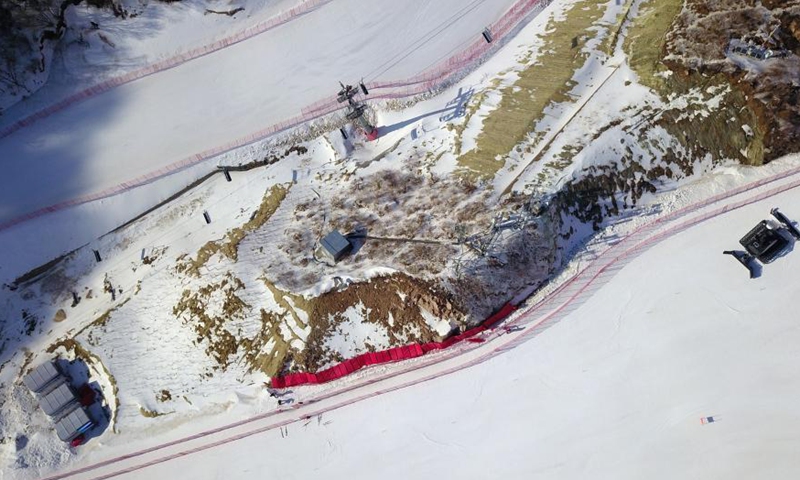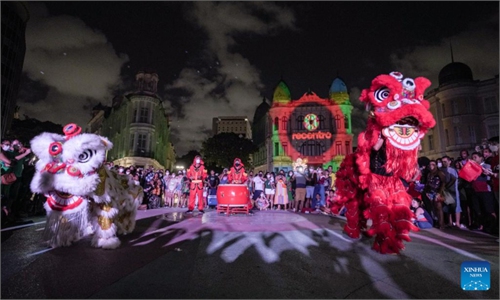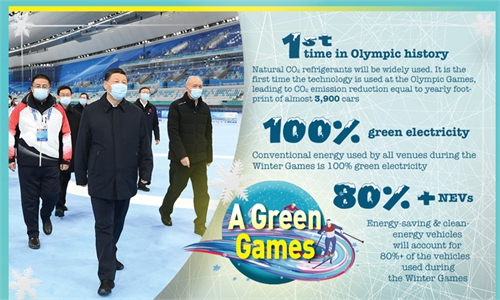BEIJING 2022 / THUMBS-UP TO BEIJING 2022
Foreign athletes ‘blown away’ by amazing race conditions, spectacular venues as they start practice sessions ahead of Beijing Winter Olympics

Aerial photo taken on Jan. 19, 2021 shows the National Alpine Skiing Center in Yanqing District, Beijing, capital of China. Photo:Xinhua
Athletes to the Beijing Winter Olympics 2022 have been busy at practice sessions and getting used to different competition venues as the games will begin with early rounds of curling on Wednesday. Some foreign athletes applauded the amazing race conditions, as the Games venues feature ecological-friendly facilities and arrangements embedded with technology and innovation that help athletes to deliver a high level performance.
The first day skiing here in Yanqing and "I'm blown away by the venue we get to compete at," US skier Ryan Cochran-Siegle was quoted as saying in a tweet shared by US Ski & Snowboard Team on Sunday night, and the skier took the day to explore the whole mountain and "got a good first look at everything."
"Spectacular snow and tantalizing terrain should make for some amazing race conditions," he said.
American curler Chris Plys also shared a video on his own Twitter as he stood in Ice Cube, converted from the National Aquatics Center, known as the "Water Cube," where star American swimmer Michael Phelps won a record eight gold medals, and said that "this is what I've dreamed about. I have a blown up photo of Phelps blown up over my desk from these games from this stadium. Now, we get to play in that same arena. Dream come true."
During the Winter Games, 39 venues will be utilized. Five venues from Beijing 2008 Olympics will be reused in 2022.
US Hockey team also went on a practice session on Sunday at the Wukesong Sports Center, and the team "got a feel for what the atmosphere on game days is going to be like, skating on the competition rink is always special," according to a statement on its website.
The team started their first practice on Saturday when it took the opportunity to skate the jet lag off, and as more delegations arrive, the excitement continues to grow around the village and at the venue, the USA Hockey said.
The venues for the Beijing Winter Olympic Games have been equipped with all types of high-tech tools to ensure the global sporting event is held without a hitch. The Ice Cube, for example, a curling arena transformed from the former Beijing Summer Olympic Games' swimming pool, is the first venue in the world to achieve a "water-ice transition."
The construction of the Olympic stadiums also incorporated green concepts with innovative practices and technological breakthroughs, which underlined China's capacity in the field of infrastructure construction.
The National Speed Skating Oval is an example of science and technology innovation, demonstrating China's comprehensive approach to Olympic stadiums from design and technological application to materials and manufacturing, according to a statement sent to the Global Times by the Beijing State-owned Assets Management Co, which operates the National Stadium, the Beijing National Aquatics Center, and the National Speed Skating Oval.
The National Speed Skating Oval realized the world's largest span (at 198 meters) orthogonal two-way saddle-shaped cable-net roof, and mastered the technology of high-vanadium airtight cables - a technology new to China, according to the statement.
Tackling the technology bottleneck resulted in the setting up of the first domestic production line of high-vanadium airtight cables, which helped push the reduction of domestic cable price by two thirds, and shortened delivery cycle by half. The breakthrough allowed such cables to be quickly applied to the construction of other large-scale venues in China, the statement said.
The National Speed Skating Oval also just used one fourth of steel needed for the traditional steel roofing, reflecting the concept of green Olympics.



